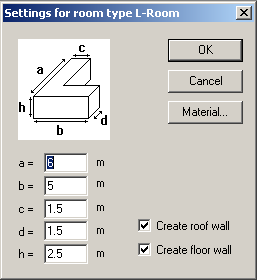Create Indoor Database with LEGO
The Lego tool provides a couple of easy to use functions for indoor database creation. The main idea is the generation of basic wall combinations (the so-called “templates”) describing typical database elements such as rectangular rooms, staircases and roofs The user-friendly graphical interface offers dialog based entry of fundamental template parameters (dimensions), post-creation editing possibilities (moving, scaling, rotating), the definition of any combination of database walls as a template, recombination possibilities for known templates and a program toolbar for fast selection of the tool to be used.
The LEGO toolbar can be found by default at the top side of the WallMan window.
| Rectangular room | Roof | ||
| L-shaped room | Stairs | ||
| T-shaped room | Cylinder | ||
| U-shaped room | Sphere | ||
| S-shaped room | Staircase |
To create a LEGO element, select a type from the LEGO toolbar and edit the values in the appearing dialog.

Figure 1. The Settings for room type L-Room dialog.
After closing the dialog with OK, WallMan shows the new element in the active 2D view. Double-clicking on the element changes between move and rotate mode. The element can be moved and rotated by clicking on it and moving the mouse.